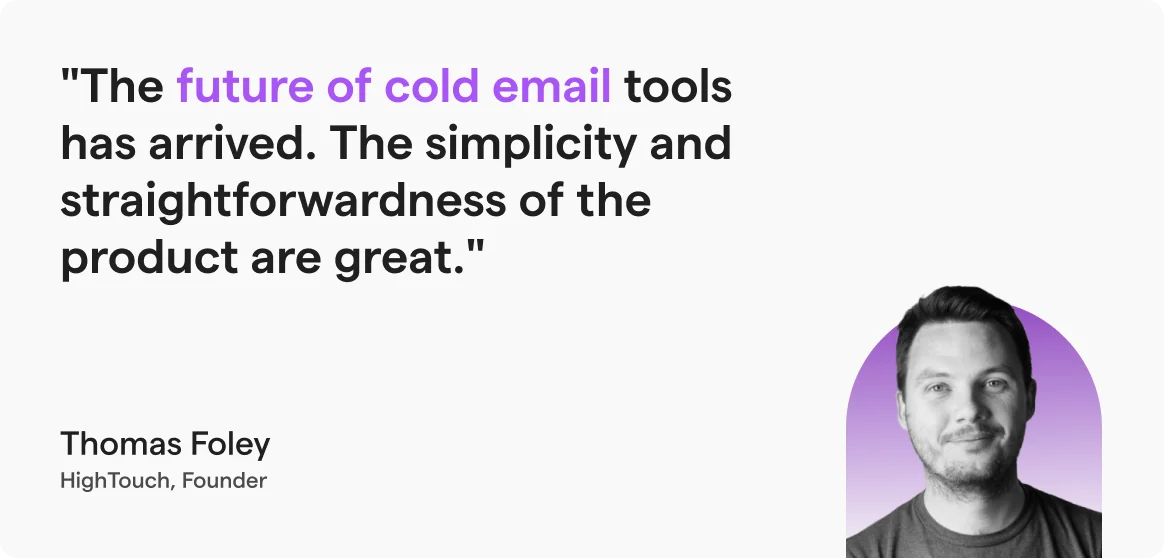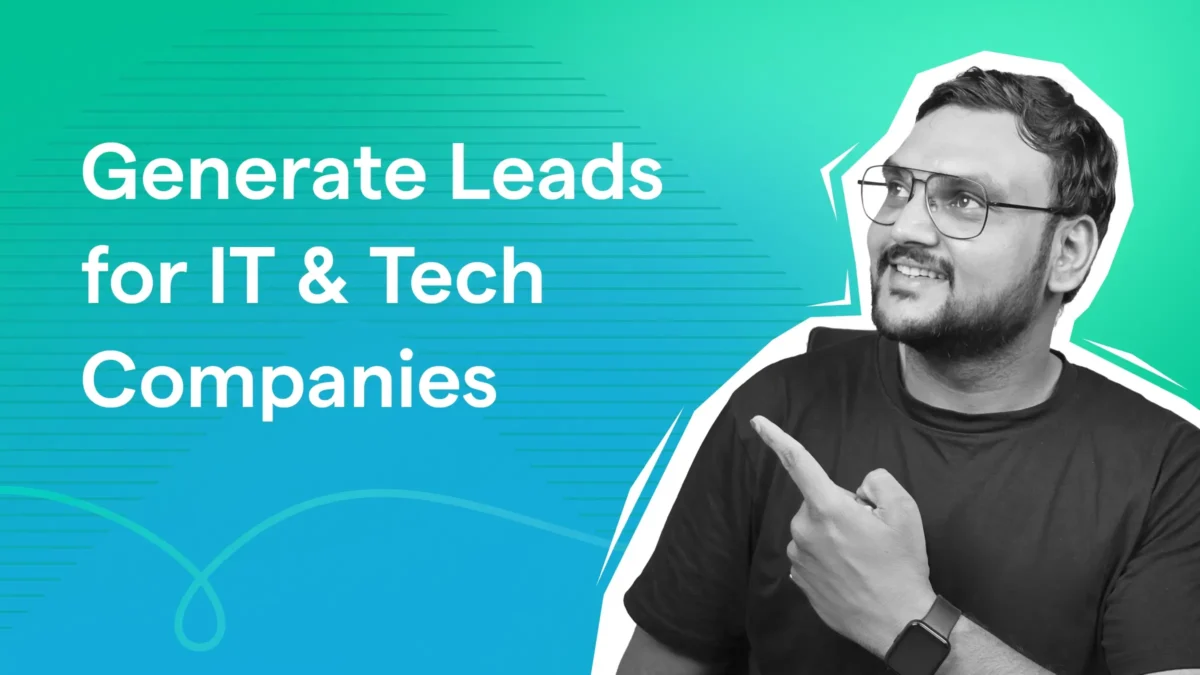Contents
- 1 Lead Generation for IT Companies – TOC
- 2 TL;DR – Quick & Sustainable Way to Generate Leads Fast
- 3 10 Sure-Shot Lead Generation Ideas for IT Companies
- 3.1 1. Send Personalized & Targeted Cold Emails
- 3.2 2. Build Relationships & Reach Out on LinkedIn
- 3.3 3. Call High-Intent Prospects
- 3.4 4. Account-Based Marketing (ABM)
- 3.5 5. Grow Your Network With Potential Clients
- 3.6 6. Content Marketing + SEO
- 3.7 7. Run Targeted Paid Ads
- 3.8 8. Build Your Personal Brand
- 3.9 9. Create a Referral Program
- 3.10 10. Create Lead Magnet Campaigns (& Promote It)
- 4 Lead Generation is a Long Game — Play It Smart
- 5 FAQs
- 5.1 1. Which lead generation strategy works fastest for IT companies?
- 5.2 2. What’s the most cost-effective lead gen method for a small IT agency?
- 5.3 3. How do I know which strategy is right for my company?
- 5.4 4. Do I need expensive tools to generate leads?
- 5.5 5. How do I track ROI on my lead generation efforts?
- 5.6 6. What’s a good lead-to-client conversion rate for IT companies?
I’m not here to share a magic trick that will solve all your problems.
This blog is meant for IT and tech businesses that want to generate leads.
That’s why I will suggest proven lead generation strategies that most successful IT companies follow.
By the end of this blog, you will know:
- Which strategies work best for lead generation
- How to plan and execute them
- What are the best practices
- AND how fast can you expect to reach ROI
Alright, let’s get into the good stuff.
Lead Generation for IT Companies – TOC
TL;DR – Quick & Sustainable Way to Generate Leads Fast
If you’re in a hurry and want a reliable lead generation method, I recommend these two:
- Send Personalized & Targeted Cold Emails: I recommend this strategy because it gives the highest possible ROI as compared to any other strategy.
- Build Relationships & Reach Out on LinkedIn: This approach is ideal if you want to avoid spending a lot and have a laid-back yet sustainable strategy.
There are many other ways to generate leads, which I will cover in detail in the following section.
10 Sure-Shot Lead Generation Ideas for IT Companies
After trying different things with my team and seeing what brings in real results, I’ve found a few approaches that consistently work.
And to make sure it’s not just theory, I’ve explained how each one fits specifically for IT or software companies.
- Send Personalized & Targeted Cold Emails
- Build Relationships & Reach Out on LinkedIn
- Call High-Intent Prospects
- Account-Based Marketing (ABM)
- Grow Your Network With Potential Clients
- Content Marketing + SEO
- Run Targeted Paid Ads
- Build Your Personal Brand
- Create a Referral Program
- Create Lead Magnet Campaigns (& Promote It)
1. Send Personalized & Targeted Cold Emails
Cold Emails Work for: Companies aiming to initiate conversations with hard-to-reach decision-makers in specific industries or roles, especially when targeting new markets or launching new services.
- When to Expect ROI: 1-2 months
How Cold Emails Help in Lead Generation
You might’ve heard that cold emails are dead. But is it true?
Or is it just that most of them run ineffective campaigns?
The truth is – cold emails are known for delivering the highest ROI compared to all other lead generation campaigns.
For IT and software companies, where clients are often high-ticket, this channel is a game-changer.
Just think about it:
Reach out to 1,000 targeted prospects…
Even with just a 0.5% to 1% conversion rate, you’re landing 5–10 qualified leads.
That’s not just doable, it’s something even beginners in cold emails can achieve.
Here’s the process you need to follow (I’ve tried this myself, and it works!!!),
- Find the Right Leads & Segment Them:
Don’t blast emails to every inbox in a 50-mile radius. Use data to find decision-makers (like CTOs or managers) who are interested in your services. Segment them by pain points, like “struggling with cloud migration.”
- Create Hyper-Personalized Emails (With Value):
You need to invest time and create emails that feel like you’re solving their specific problem. Make them think, “This person gets me.” - Set Up a Fully Automated Email Sequence With Targeted Follow-Ups:
Your email sequence should send emails based on the user’s behavior and interest level.
After this, all you need to do is reply to the interested prospects, and you are good to go.
To make this process simple, I suggest you use a cold email software that can help you find leads with AI and set up advanced cold email campaigns.
Psst – Want to send cold emails across time zones and track every reply? Saleshandy makes it easy — it’s what global teams rely on!
Why? Because Saleshandy allows you to:
- Find leads with AI from a B2B database of 700M+ professionals
- Create personalized emails that have a better chance of converting
- Create condition-based follow-ups with the help of sub-sequences
- Improve campaign performance with advanced email deliverability features
The best part – It can also rate your sequence and give a score so that you can improvise and avoid spam filters.

That’s just the beginning, but you can take a 7-day free trial and experience the potential of your cold emails.
Best Practices for Cold Emails
- Reach out to relevant prospects only
- Send emails in your recipient’s local time
- Use compelling subject lines to grab attention
- Personalize each email with name, company, and pain points
- Focus on value and solutions, not just your services
- Use a clear and specific call to action
- Avoid spammy words to stay out of spam folders
- Send follow-up emails to increase your chances of getting a response
- A/B test your emails to improve open and reply rates
Cost & Resources Needed
If you want to launch your cold email campaign, you can start at a very minimal cost of $25-$55 per month with a suitable tool.
My honest recommendation: Saleshandy. It is quite budget-friendly and offers numerous cool features that will help you achieve a faster ROI.
2. Build Relationships & Reach Out on LinkedIn
LinkedIn Outreach Works for: Connecting with B2B buyers, nurturing long-term relationships, and establishing credibility among tech-savvy professionals + business leader.
- When to Expect ROI: 2-3 Months
How LinkedIn Outreach Helps in Lead Generation
LinkedIn has the potential to be a lead-generating machine for almost all kinds of B2B companies.
And no one can question that.
All it comes down to is – How you execute the strategy.
Here’s how you can do LinkedIn outreach the right way:
- Step 1: Search Relevant Leads on LinkedIn:
For example, you can use LinkedIn’s search to find decision-makers, like “CTOs in the healthcare industry,” and then segment them by their needs. - Step 2: Engage Before You Pitch: Like or comment on their posts with thoughtful insights, such as “Great point on cloud security!” You need to build a genuine rapport before sliding into their DMs.
- Step 3: Send Hyper-Personalized Connection Requests: Try mentioning their recent post or company milestone, e.g., “Loved your SaaS scalability post, let’s connect!!” to stand out.
- Step 4: Share Valuable Content & Follow Up: Post case studies or message them with tips, like “How we cut downtime 30%,” and follow up if they engage.
- Step 5: Move to a Call or Email: Once they respond, shift to a quick call or email (via Saleshandy’s sequences) to close the deal.
I suggest that you use a LinkedIn extension for finding and saving the lead details. This helps you keep yourself on track with the outreach.
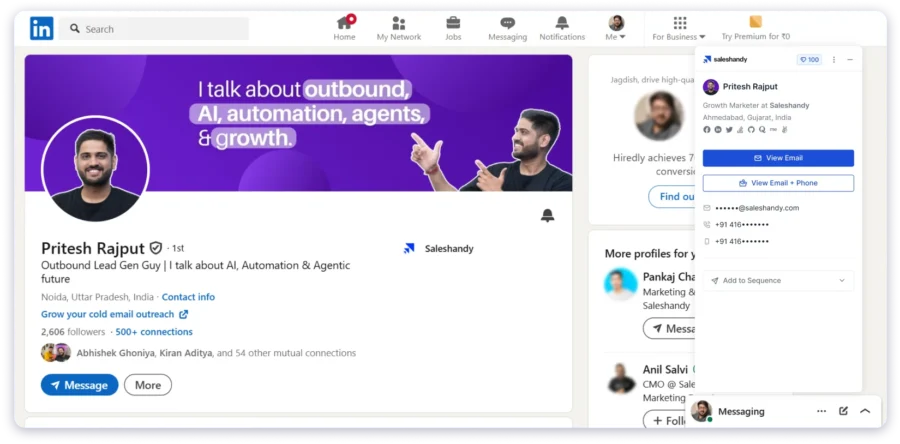
Because I know that when we prospect on LinkedIn, we often get carried away and reach out to too many people, ultimately missing out on some of them.
But what if —— You don’t get any response on LinkedIn?
There’s another cool thing you can do to generate leads faster.
- You can find emails from LinkedIn with a tool
- And then reach out to them by sending cold emails
(when they don’t reply on LinkedIn)
And trust me – this method works wonders!!
Best Practices for LinkedIn Outreach
- Personalize connection requests and messages.
- Share insights, case studies, and thought leadership content.
- Engage in relevant groups and discussions.
- Use LinkedIn Sales Navigator for advanced targeting.
Cost & Resources Needed
Usually, if you want to reach out on LinkedIn on a small scale, it won’t cost you much. In fact, you can pretty much do it for free.
However, if you want to bulk prospect, the cost can range from $25 to $150 per month.
- $0-$25 if you use Saleshandy Connect
(If you want to perform bulk prospecting on LinkedIn) - $50 (average) if you use Dripify (for automating LinkedIn outreach)
- $120+ if you use LinkedIn Sales Navigator
3. Call High-Intent Prospects
Cold Calling Works for: Quickly qualify leads and reach out to prospects who have shown buying signals.
- When to Expect ROI: 2-4 weeks
How Cold Calling Helps in Lead Generation
Cold calling is your go–to strategy if you want to quickly qualify leads and establish a two-way conversation to discuss mutual interests.
(But mind it, cold calling is way different from cold emails.)
It helps in two ways
- Reduce your sales cycle
- Target high-intent clients quickly
For IT companies, it’s effective for following up with inbound leads, event attendees, or those who have engaged with your content.
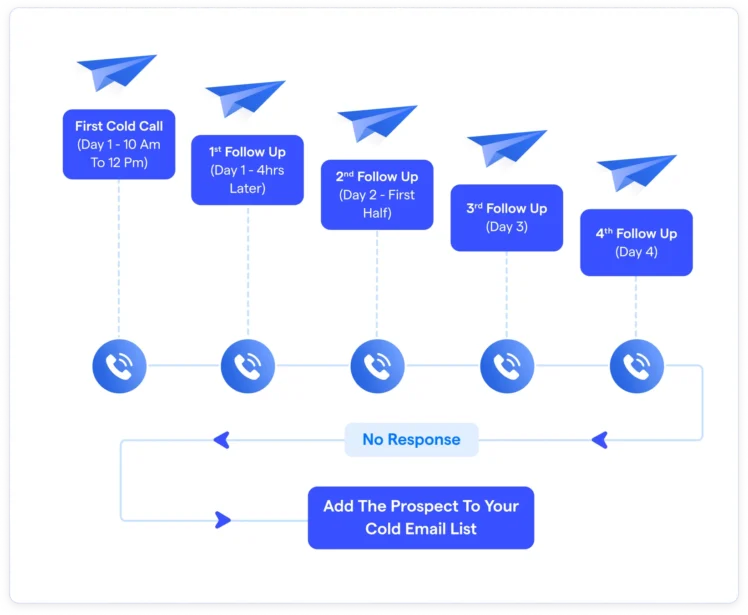
This approach is best if you want to give a personal touch and humanize your outreach (and of course accelerate the sales process).
This strategy works best when clubbed with cold emails.
It’s like, when you call them 3-4 times, if they don’t pick up your call, then you can reach out to them via cold emails. It’s a smarter way to make the most out of your lead list.
PS. If you’d like to learn more, you can visit my blog on how to make cold calls.
Best Practices for Cold Calling
- Call at the best times (like in the morning between 10 am to 1 pm during weekdays, in their local time)
- Use researched, hyper-personalized scripts
- Listen actively and address pain points
- Track and analyze call outcomes to improve
Cost & Resources Needed
Usually, all you need is the phone number of your prospects, but sometimes you need more details.
For example, you would want intent data so that you can call when the prospect is most interested in what you have to offer.
For this, the costs can range from a minimal $15 per month to $50 per month, depending on your needs.
Here are the tools I will suggest to you,
- Saleshandy B2B Lead Finder or Apollo – to get contact information
- Clay – for data enrichment and getting intent data
- Aircall – for cold calling
4. Account-Based Marketing (ABM)
ABM Works for: Targeting high-value enterprise accounts with personalized campaigns.
- When to Expect ROI: 2-6 months
How ABM Helps in Lead Generation
ABM flips the traditional lead generation model. Instead of casting a wide net, you focus all your resources on a select group of high-value accounts.
This approach works especially well for IT and software companies that sell complex solutions.
Because let’s face it, your ideal clients aren’t going to convert after seeing a broad Google ad or downloading a random whitepaper.
They need relevance. Precision. A reason to pay attention.
That’s exactly what ABM gives you. You can,
- Personalize outreach based on account-specific needs and pain points
- Align your sales and marketing teams to pursue the same accounts strategically
- Build trust with multiple stakeholders in the same organization to speed up complex sales cycles
It’s especially powerful when you’re trying to break into niche industries or land enterprise clients with long buying journeys.
Here’s what it looks like when our sales guys try to target high-intent users. See how they are filtering hot leads.
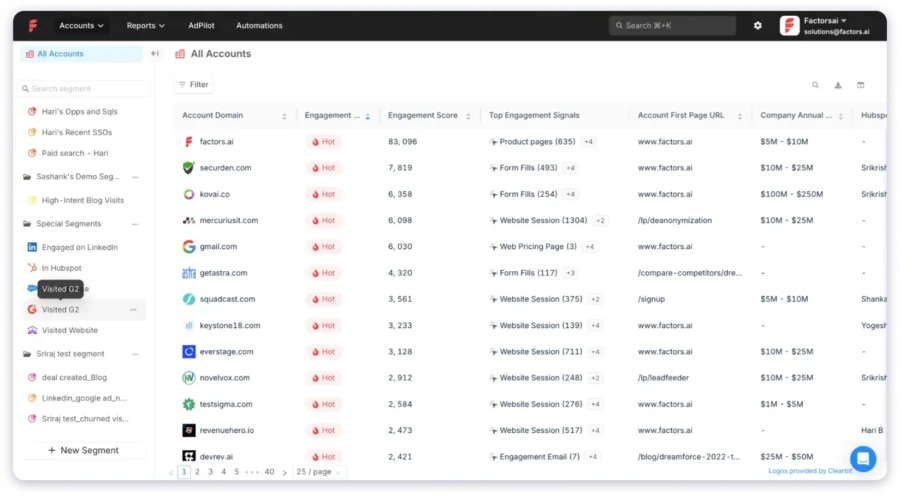
For example, instead of sending a generic ebook to everyone, you can send a custom audit report to just 10 decision-makers from 3 high-ticket companies.
This kind of personal touch will get you meetings — and that’s how you win big in B2B tech.
Best Practices for ABM
- Align sales and marketing on target accounts.
- Use intent data to prioritize accounts.
- Personalize outreach and content for each account.
- Measure and refine campaigns based on results.
Cost & Resources Needed
ABM can be resource-intensive, but it pays off big when done right. Here’s what you may need:
- A list of target accounts (you can build this using tools like Apollo or Saleshandy)
- Intent and firmographic data (ZoomInfo, Clay, etc.)
Typically, you can set up starter campaigns for $50 per month with manual efforts and low-cost tools.
However, if you opt for advanced ABM campaigns, the costs can increase to $ 500 or more per month.
5. Grow Your Network With Potential Clients
Networking Works for: Building trust and relationships with potential clients in person or virtually.
- When to Expect ROI: 1-3 months
How Networking Helps in Lead Generation
Networking is one of the most underrated ways to generate leads.
I’m not talking about adding 1,000 random people on LinkedIn.
What I mean is that you genuinely connect with folks who could be your potential clients (or know someone who is).
Because here’s the thing – people buy from people they trust.
For IT and tech businesses, where stakes are high, trust plays a major role.
When someone knows you (or knows of you through a mutual connection), you’ve already skipped the hardest part of cold outreach: building credibility.
You can start by attending webinars, participating in community forums, joining Slack groups, or even commenting on posts of decision-makers in your niche.
Once they see you adding value, you become memorable—and that’s when the magic happens.
Best Practices for Networking
- Attend events where your ideal clients are present.
- Prepare a concise value proposition.
- Follow up promptly after events.
- Consider speaking or hosting to increase visibility.
Cost & Resources Needed
This is probably the cheapest strategy in terms of money, but it does cost time and consistency.
Most networking happens online these days – LinkedIn, Twitter, tech communities, and events on platforms like Eventbrite or Meetup.
If you want to keep things organized, use free tools like Notion or a basic CRM to track people you connect with.
However, you can get started with $0 and a willingness to build genuine business relationships.
6. Content Marketing + SEO
Content Marketing + SEO Work for: Attracting inbound leads and establishing authority.
- When to Expect ROI: 3–6 months for initial traction; 6–12 months for significant
How Content Marketing + SEO Helps in Lead Generation
For IT and tech companies, content and SEO are among the most effective ways to educate their audience, establish authority, and attract high-quality inbound leads over time.
But is it worth the time and effort?
The answer is yes. To prove my point, I did some research.
I picked a keyword (“fintech app development services”) and checked the performance of the top-performing pages.
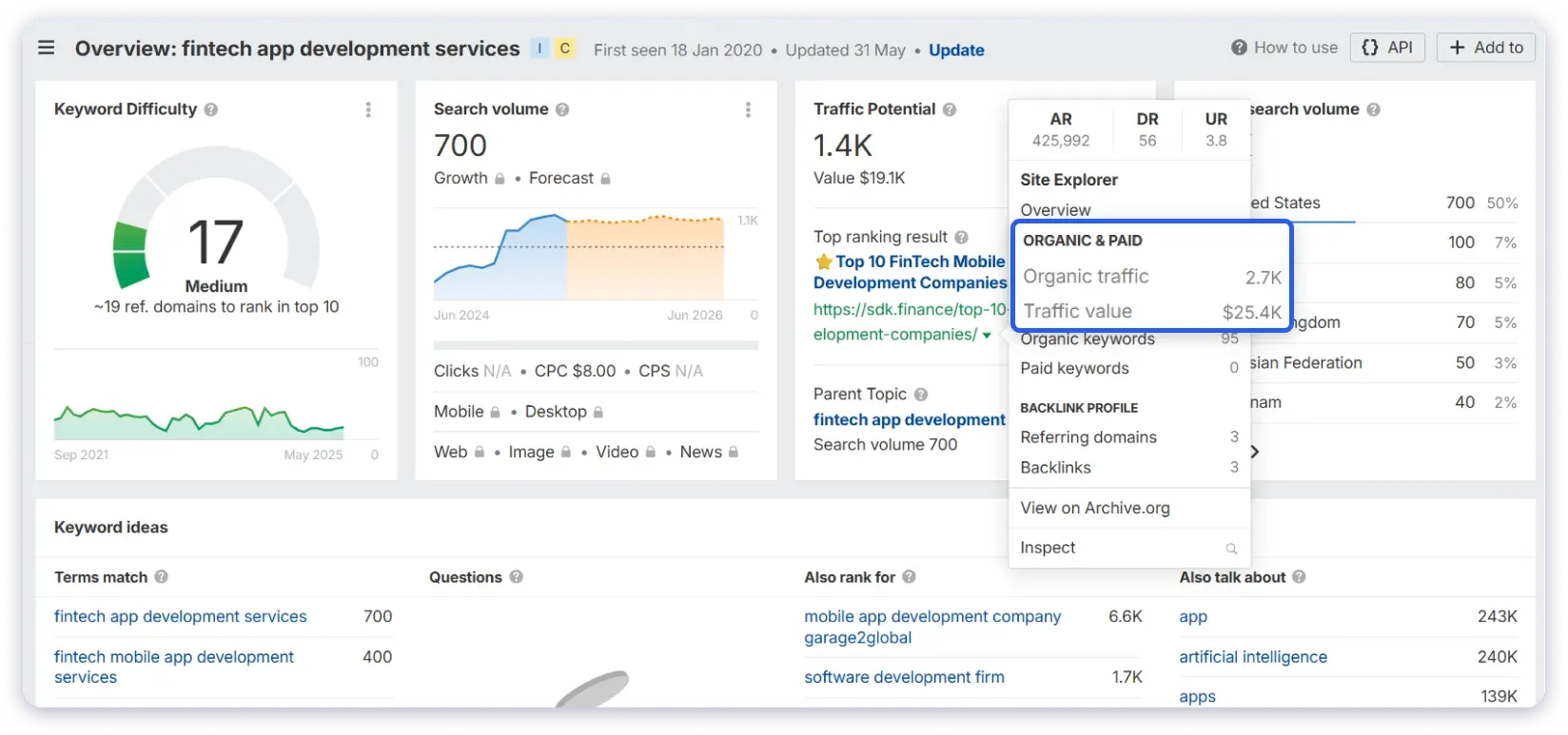
I was shocked to see that a page by SDK.finance, which captures nearly 2.7k traffic per month, has a traffic value of $25,000.
Which means that this company is potentially saving $25,000 of ad budget (every month), which they would have to spend to bring this much traffic.
This is a result of consistency in creating helpful content (like solution-focused blogs, case studies, or technical guides).
This type of content appeals to individuals who search for answers. And when you combine that with solid SEO, your content shows up exactly when prospects need it.
This works exceptionally well if you’re targeting specific industries or use cases.
Note: Content marketing is not limited to text. Webinars, videos, podcasts, and newsletters help you move leads down the funnel.
You won’t get results overnight, but give it a few quarters, and content can become your most significant lead generator.
Best Practices for Content Marketing + SEO
- Address customer pain points in your content.
- Optimize for relevant keywords.
- Create content for all funnel stages (awareness, consideration, decision).
- Regularly update and promote content.
Cost & Resources Needed
You can start small – just you and a Google Doc.
But to scale this properly, you’ll need some basic tools.
You just need a good SEO tool like Ahrefs (or Ubersuggest if you’re on a budget), a content calendar (even Notion works), and someone to write and optimize content consistently.
If you’re outsourcing, blog content can cost $50–$200 per piece, depending on quality.
If you’re keeping it in-house, it’s mostly time + research. But once your content starts ranking, you’ll keep getting leads without spending a rupee more.
7. Run Targeted Paid Ads
Paid Ads Work for: Generating leads quickly and reaching specific audiences at scale.
- When to Expect ROI: 1–2 months
How Paid Ads Helps in Lead Generation
Let’s be real—paid ads aren’t cheap.
But when done right, they can flood your pipeline with high-intent leads fast.
For IT and tech companies, especially those selling niche or high-ticket solutions, ads can work wonders if you target the right audience with the right message.
And I’m not talking about boosting a random post on Instagram.
I’m talking about precision targeting using LinkedIn Ads, Google Search, or even programmatic ads that are shown only to relevant decision-makers.
For example, let’s pick the keyword “custom ERP software development”. It has a CPC (cost per click) of $15.
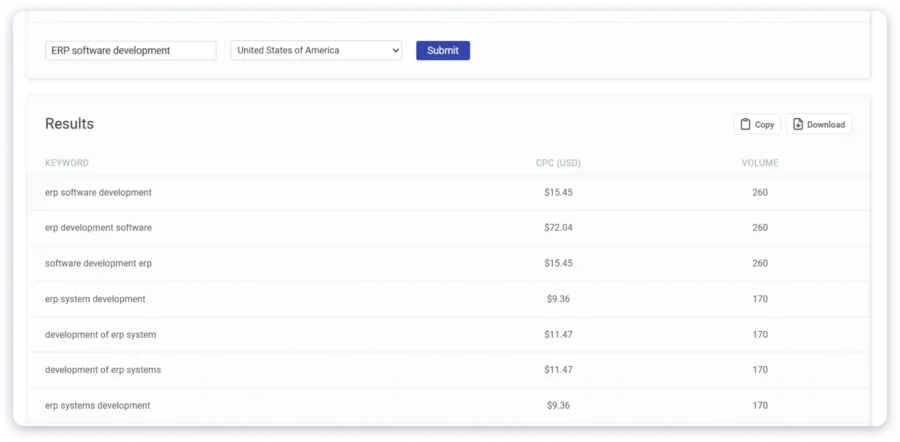
Why would companies spend $15 per click?
Because clicks on these keywords come from decision-makers actively looking for a solution.
That means your chances of converting them are significantly higher.
So, if you run a well-structured campaign that offers something useful, like a free consultation or audit, this could turn a $15 click into a $15,000 client.
Plus, when you combine paid search (Google) with paid social (LinkedIn), you can create a double-layer strategy:
- Search Ads catch leads with intent (they’re already looking).
- Social Ads warm up leads who don’t know you yet but match your Ideal Customer Profile (ICP).
Also, don’t forget retargeting.
Visitors who bounce from your site can be retargeted with testimonials, product tours, or client results — bringing them back when they’re ready.
Best Practices for Paid Ads
- Define clear objectives and KPIs.
- Use precise audience targeting.
- Continuously test and optimize ad creatives.
- Retarget website visitors for higher conversion.
Cost & Resources Needed
Ad spend and management fees; budgets typically start at $500/month.
Here’s a quick breakdown:
- Google Ads: Expect to spend $500–$2,000/month to test effectively.
- LinkedIn Ads: Higher cost, but highly targeted. It can cost you around $800–$2,500/month for real results.
- Tools: You can use platforms like Google Ads, LinkedIn Campaign Manager, and a tool like Unbounce or Webflow for conversion-optimized landing pages.
- Optional: Use AdEspresso or Madgicx for optimization and performance tracking.
TL;DR: Paid ads are expensive. But if you focus on buyer intent, tight targeting, and strong CTAs, you can absolutely generate qualified leads at scale.
8. Build Your Personal Brand
Personal Branding Work for: Establishing authority and trust in your niche, especially for founders and key team members.
- When to Expect ROI: 4-9 months
How Personal Branding Helps in Lead Generation
People don’t trust logos (at least not easily). They trust people.
That’s exactly why building a strong personal brand can be a game-changer for lead generation (especially in the IT and tech industry).
Let’s say you’re the founder of a SaaS startup or a consultant selling enterprise software.
If you consistently show up on platforms like LinkedIn — sharing real insights, industry trends, personal experiences, or even client wins — you start building credibility.
And in B2B, credibility = currency.
When your ideal buyers see you as a domain expert, they’re far more likely to take that demo call, reply to your email, or fill out your contact form.
Even better? They might come looking for you.
Here’s something interesting:
LinkedIn’s algorithm favors content from individuals over company pages.
That means your personal posts will likely get way more reach than anything your company shares.
You don’t need to go viral — you just need to stay visible and valuable.
A few consistent posts per week, a strong opinion, and real value can generate way more inbound interest than you’d expect.
Best Practices for Personal Branding
- Post consistently and authentically.
- Share real experiences and expertise.
- Engage with your audience’s comments and questions.
- Collaborate with other industry voices.
Cost & Resources Needed
The best part? Building a personal brand doesn’t require ad spend or fancy tools.
All you need is:
- A solid LinkedIn profile (or X, better if both)
- Content ideas that resonate with your niche
- Tools like Taplio or Publer (if you want help with post writing and scheduling)
- Optional: A ghostwriter or content strategist if you want to scale faster
It’s a time investment, not a money one.
However, over time, this approach fosters a warm audience, resulting in easier conversions, shorter sales cycles, and even referrals without needing to ask.
9. Create a Referral Program
Referral Programs Work for: Leveraging satisfied customers and partners to generate warm leads.
- When to Expect ROI: 2-4 months
How Referral Programs Help in Lead Generation
Sometimes, your next best client isn’t hiding in a list — they’re sitting in your network’s inbox.
That’s why referral programs work so well, especially for IT and tech companies offering specialized services.
Happy clients already trust you. So when they refer someone your way, that trust transfers instantly. It’s like skipping the entire cold outreach phase.
Referrals often close faster, cost less to acquire, and have a higher lifetime value.
In fact, according to Nielsen, people are 4x more likely to buy when referred by someone they know.
Let’s say you just delivered a killer cloud migration project for a client.
This is the perfect time to reach out and say,
“Hey, if you know someone facing similar challenges, I’d love to help them out — and we’ll make it worth your while.”
You can keep it simple:
- Offer a discount or cash reward for every successful referral
- Or go the value route — offer a free consultation or bonus service to both referrer and referee
The key? Make it easy to refer and worth their time.
Also, don’t just rely on clients. Past leads, partners, and even vendors can be great referral sources if you build a strong network around your brand.
Best Practices for Referral Programs
- Make it easy for customers to refer others.
- Offer meaningful incentives.
- Regularly remind and thank participants.
- Track and optimize referral sources.
Cost & Resources Needed
Referral programs are flexible and cost-effective. Here’s what you’ll need:
- A simple system to track referrals — can be manual (Google Sheets) or automated (tools like Referral Factory, PartnerStack, or even Zapier + Typeform)
- Incentives — either fixed rewards ($100 per referral), % off next invoice, or exclusive perks
- A clear process — tell people exactly how to refer and what they’ll get
This strategy doesn’t demand huge budgets — just consistency, goodwill, and a good offer.
10. Create Lead Magnet Campaigns (& Promote It)
Lead Magnets Work for: Capturing contact details from website visitors and nurturing them into leads.
- When to Expect ROI: 1-3 months
How Lead Magnets Help in Lead Generation
No one gives away their email for free.
You’ve got to earn it. And that’s where lead magnets come in.
For IT and tech companies, lead magnets are a smart way to attract high-intent leads by offering something genuinely valuable in exchange for their contact details.
It’s a win-win: they get answers or insights, you get a qualified lead.
Here’s how it works:
You create a resource that solves a real, relevant problem your ideal customer is facing. For example, you can create:
- Technical whitepapers
- ROI calculators
- “How-to” guides for decision-makers
- Case studies
- Comparison checklists
- Free tools or templates
But just creating a lead magnet isn’t enough. You need to promote it consistently — through LinkedIn posts, cold email CTAs, website banners, even paid ads if the offer is strong enough.
And once they opt in? Nurture them. Don’t just drop a PDF and ghost them — follow up with helpful content, or trigger a personalized email sequence.
This strategy may take some upfront effort, but the payoff is long-term lead flow on autopilot.
Best Practices for Lead Magnets
- Ensure the lead magnet solves a real problem.
- Use clear, compelling landing pages.
- Promote across multiple channels.
- Follow up with a nurturing sequence.
Cost & Resources Needed
You can start with almost zero budget, or scale it up later with automation and design. Either way, it’s one of the most repeatable and passive ways to generate leads.
Lead Generation is a Long Game — Play It Smart
I’ve listed 10 strategies that you can adopt for generating leads.
But here’s what I recommend for you – Pick 2-3 strategies & balance them!!!
Here’s how,
- Pick a quick returns type strategy – Cold emails
- Pick a long-term strategy – Personal branding or ABM
This will help you balance the investment-to-return ratio.
For starters, you can try sending cold emails in Saleshandy with a 7-day free trial and see how it works out.
FAQs
1. Which lead generation strategy works fastest for IT companies?
Cold emailing and cold calling tend to bring the fastest results, especially when targeting a niche audience with high buying intent.
2. What’s the most cost-effective lead gen method for a small IT agency?
LinkedIn outreach and cold emails are low-cost and high-ROI if you have the right tools and messaging. Content marketing is also cost-effective, but it takes time.
3. How do I know which strategy is right for my company?
It depends on your audience, sales cycle, and budget. If you sell high-ticket B2B services, strategies such as account-based marketing (ABM), referral programs, and LinkedIn can be effective. If you’re building brand authority, go for SEO and personal branding.
4. Do I need expensive tools to generate leads?
Not really. You can start learning using tools like Saleshandy, Hunter, LinkedIn extensions, and email platforms under $50/month. Scale up tools as your pipeline grows.
5. How do I track ROI on my lead generation efforts?
Use simple tracking systems like CRMs (HubSpot, Zoho), UTM parameters for links, and email campaign analytics. Track metrics like conversion rate, cost per lead, and deal velocity.
6. What’s a good lead-to-client conversion rate for IT companies?
It varies, but for cold outreach, even a 1-5% conversion rate is solid.
For warm leads (like referrals or SEO leads), you can expect 5–10% or more, depending on your niche and sales process.
sales

